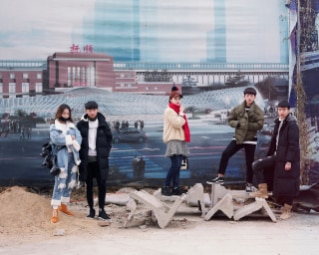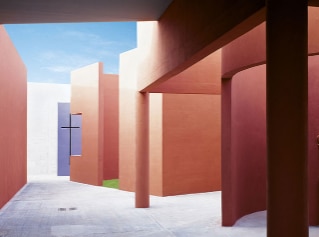Carson Chan: Architecture is the spatial practice of a body of knowledge that deals with socio-historical contexts, structures and subjective experience.
You often say "Not all buildings are architecture". I wonder how you define a building and how you judge architecture and give it a value. Could you elaborate a little? What method do you use to decide whether a particular object is architecture?
Buildings are physical structures that we live in. They protect us against the elements. Architecture in building form reflects the desire to communicate ideas or concepts via a built structure. Traditionally, the architectural ideas conveyed through buildings have been about living (our wellbeing) and socio-political ideology. Architects have also tried to express literary ideas such as deconstruction via architecture, to varying degrees of success. Architecture does not have to occur in building. We can find examples of architecture in many other disciplines. John Cage's music and Olafur Eliasson's artwork are obvious examples of architecture outside building design.
Do you feel more like a critic, a writer, an architect or a curator... Which of these activities is most important to you?
I guess I would say those of writer and curator but always in relation to my work as an architectural practitioner.
In May 2010, I had the honour of your presence in Wroclaw, Poland, as a guest at the Ex-Architects project. Are such activities – lectures and discussions on the identity of architecture – important? Do they make sense? Does asking such questions help define architecture?
Yes, I would say such activities are absolutely essential to architecture – particularly when there are non-architects in the audience. Your average person engages regularly with and has opinions on films, literature and music but hardly gives a thought to buildings, let alone architecture. I hope to 'engage' people in thinking about the built world and the meaning of the experiences it both provides and produces.
Let's talk about the curatorial aspect of your work. I would like to ask you about your curatorial approach, which combines a number of your fields of interest, including architecture. Could you elaborate and characterise both your approach and your attitude, which were manifest in your work as a curator of the Neue Nationalgalerie in Berlin, where you organised an evening of panel discussions with leading artists, architects and curators to commemorate the 40th anniversary of the Mies van der Rohe building and at Program (in exhibitions such as Markus Miessen & Ralf Pflugfelder in collaboration with John McCusker; 1,000, Le Chamois de Messidor; Eemil Karila: Surface Values; and many others). How did you perceive them as a curator and which of their elements did you want to stress as the most significant?
In all of my curatorial activities, I try to express architecture through the exhibition experience not portrayals of it. At Program, we never show pictures or drawings (e.g. plans, sections, elevations) of buildings. A plan of a building tells you very little about it other than its size and layout. A photograph shows you what a building looks like but this, too, is a reduction of what the architecture communicates, which comes via the physical experience. Our Program exhibition with Markus Miessen, Ralf Pflugfelder and John McCusker was a continuation of an exhibition Markus and Ralf held at the Dusseldorf Kunstverein. At Program, they wanted to create the sense of walking into a cathedral-like space so they blackened the room and put contact-microphones under a walkway, which fed into a mixer that amplified the visitors' footsteps with an echo. This experience was devised to comment on how religions have used scale to create a feeling of devotion in their audience. Walking into a large space makes us feel small and a quasi-spiritual effect is produced by manipulating people's sense of space in the gallery. The architectural intention is shown rather than represented.
Does curating architecture have a different meaning from curating fine arts? I think this is the question that intrigues most of the non-professional audience when they visit architectural exhibitions or events such as the Venice Biennale.
Curating, in general, is the process of mediating between the work and the audience. Both artwork and architecture need to be contextualised in order to express themselves. Work incorrectly installed is distorted. Imagine Duchamp's urinal installed in a place that doesn't signify its artistic intentions...! Art and architecture are different disciplines so, naturally, their mediation requires different techniques.
What is the role of the architectural exhibition? It is usually linked to the idea of a space with heaps of models and plans showing different stages of concept development.
Traditionally, architectural exhibitions have displayed representations of architecture – like the models and drawings you mentioned. I think architectural exhibitions can show architecture without recourse to representation. Exhibitions are produced in spaces and, for me, the experience of space is the primary way that we perceive architecture.
You are the director of the Program Gallery which mainly presents exhibitions on the boundary between art and architecture but architecture is still your point of reference... So you have experience in presenting architecture. Can tell us whether you have a "middle ground" on how best to present the architecture of a gallery space that is mainly given over to spatial art? I feel the modern world still has a problem with the presentation of architecture, how to show the architecture of a gallery or museum.
As I mentioned earlier, architecture can exist in media other than building design, such as art, music or installations which are much easier to exhibit in gallery spaces. One of Program's aims is to test the boundaries between architecture and other disciplines and, in doing so, we can learn to what extent architecture is still architecture, even though it doesn't behave like a building anymore. Showing architecture also means experimenting with architecture. Architecture is traditionally embodied in buildings, which take a long time to build and cost millions but showing it in a gallery space allows for more of its most experimental forms. The gallery becomes a place where ideas are vetted and mistakes made.
I feel we have a growing need to name and classify everything. I wonder whether it is important to separate architecture and art when it comes to exhibition space. Do you not get the impression that these blurred boundaries are very flexible in spaces and museums?
I've always thought it necessary to define boundaries. Without boundaries, we wouldn't know we were crossing them.
Can you tell us a little about whose exhibitions you are working on now?
At Program, we have become quite interested in dark spaces. In a darkened exhibition space, visitors have to use all their senses to navigate their way around. We have just presented an exhibition by an experimental architectural-installation group called Raurouw. They created four different spaces with lasers designed to produce the four stages of loss and mourning. The exhibition with Miessen, Pflugfelder and McCusker was in a dark space, as were two other ones we held last year. I have also recently curated a solo exhibition in Milan with Luca Pozzi. His artwork centres on theoretical physics and it was a challenge to convey them spatially in the exhibition. We ended up using different types of light with different tones, temperatures and luminosity to show the variety and variability of ideas in these theories.
Before the Venice Biennale you were a bit wary about this year's theme and its vagueness. After visiting the event, what do you have to say about architects' ability to communicate their ideas and the meaning behind their architecture?
I would still say that the title "People Meet in Architecture" is pretty loose, to the point of being almost meaningless. Sejima, the director, made a strong statement in her catalogue text and I think her idea of using space as a primary material to express architectural ideas really comes across. The Arsenale, which was the only part completely curated by her, holds together quite well as an exhibition – it was like a succession of different experiences that activated different senses and stances to architecture. I also liked the way Sejima included artists in the exhibition. Her success lay in the fact that she showed artwork produced by artists, unlike Aaron Betsky's exhibition, which asked architects to make installations.
You often mention different ways of exhibiting architecture and new curatorial strategies present or perhaps lacking in the architectural discourse. Do you think that biennales really present innovative ideas and theories and, at the same time, are meaningful not only to architects but also to a non-architectural audience?
Biennials are celebrations more than anything else. Most of the exhibitors invited have less than one year to make something. It is a length of time that artists are comfortable working with, but most professional architects aren't used to completing projects in the span of several months – let alone in a medium, that of an exhibition, they are not accustomed to working in. Interesting ideas always emerge when people do work for the sake of exposing it to a community of like-minded people but I wouldn't go so far as to say that biennials, by definition, innovate ideas and theories.
Have you seen any inspiring exhibitions recently, something that affected you in particular?
I recently toured Hansa Viertel with some of my students. The Berlin neighbourhood was built in the late 1950s and intended as an exhibition of actual buildings. Moving around buildings by Alvar Aalto, Egon Eiermann, Walter Gropius and Oscar Niemeyer and observing how people actually live in and amongst them was a pretty satisfying experience. The organicist, modern utopian ideals of the exhibition are still conveyed quite clearly. It retains the ideology that was active in its inception.
Marcin Szczelina is an architectural writer, curator of architecture, co-curator of Biennale EVENTO in Bordeaux (2009) and Aaron Betsky's assistant at 11th Venice Architecture Biennale.





